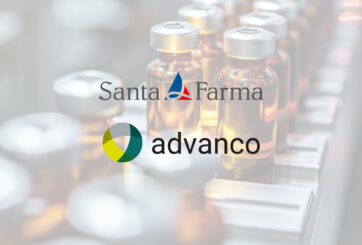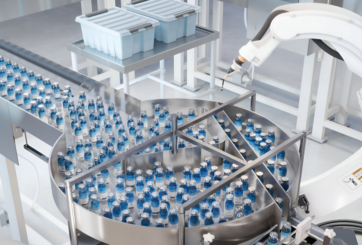Viewpoint: Track and trace can boost efficiency, cut regulatory burden in pharma
Track and trace technology is no longer a nice-to-have for pharmaceutical manufacturers, it is a must-have

The ongoing pressures that come from fighting spiraling costs on all fronts, coupled with battling an ever-growing number of worldwide pharmaceutical forgeries, means that track and trace systems are being relied upon by pharmaceutical producers more than ever before.
Add to this mix the fact that track and trace can also drive pharmaceutical compliance – something that is becoming ever more complicated to navigate – and you begin to see why track and trace have rapidly become the pharma sector’s best friend.
How track and trace can streamline pharma business operations
With businesses from multiple sectors fighting ever-rising costs right across the globe, pharmaceutical firms are prioritizing the need to streamline operations and increase efficiency.
Although this is, of course, adding extra pressure on already stretched businesses, there is a glimmer of hope. We are already seeing the emergence of Industry 4.0., which many are calling the fourth industrial revolution. This is presenting a golden opportunity for pharmaceutical firms to completely overhaul their current, often antiquated systems, that are holding them back and stopping them from reaching peak performance.
Industry 4.0. is already responsible for significant steps forward, making today’s pharma operations almost unrecognizable from just a few years ago. One clear example is provided by the emergence of robotics. This technology would once only be found in huge corporations – the ones where staff are a number and anonymity is the norm due to the sheer size of operations and the thousands of staff needed to support them.
However, huge strides forward have been made in recent years, and as a result, robotics can now be found in organizations of every size, complementing the human workforce, and carrying out their tasks with precision and reliability. Once the initial cost of this technology has been recouped, there are significant cost savings to be made in the non-payment of human wages.
We are also one step closer to seeing the smart factory become a reality.
A combination of cyber-physical systems, the Internet of Things and the Internet of Systems will all combine and complement each other to create technological magic. This will lead to smart machines getting even smarter as they get access to more data, resulting in a global pharmaceutical sector becoming more efficient and less wasteful.
This is where a watertight track and trace system will really shine. It links together the essential components that modern pharmaceutical businesses need to thrive. These components include operational shopfloor efficiency, greater warehouse automation, generating more data which will further optimize the supply chain, and creating customer engagement through product identification.
We can also expect to see vast savings being made from the introduction of edge computing – a distributed IT architecture in which client data is processed at the periphery of the network, as close to the originating source as possible.
The impact of this on the pharmaceutical track-and-trace sector will be huge, especially where overall supply-chain operations are concerned. We have already seen the beginnings of a much more agile, local supply chain. The rapid uptake of digital barcode scanning systems combined with the very latest, cutting-edge technology, has made supply chains much more secure.
New-edge computing will tighten this up even further. It will power automatic, time-sensitive supply chain processes in warehouses, factories, and manufacturing facilities. These processes will lessen the need for human management and create optimal outcomes while eliminating the risk of error due to manual processes.
How track and trace can drive pharmaceutical compliance and meet international and regional directives for pharmaceutical products
The pharmaceutical sector is one of the most tightly regulated sectors on the planet. As the industry that is directly responsible for providing life-saving medicine which is relied upon by virtually every one of us at some point in our lives, it is clear to see why it is so heavily controlled.
However, even this is not enough. Criminals continue plying their forged medicines, leading to deaths and disabilities in the millions. It is predicted that 10% of pharma products worldwide are counterfeit, with the global counterfeit drug market exceeding an eye-watering $75bn. Research further estimates that the death-toll caused as a result could increase to 10 million people by 2050.
Therefore, pharmaceutical regulation is done to ensure safety, efficacy, and quality of the drugs available to consumers. This is accomplished through a range of regulatory activities over the course of a drug’s life cycle including premarket screening and evaluation of new pharmaceuticals, inspection of manufacturing facilities, regulation of drug labeling and promotional activities, and the post-marketing surveillance of drugs following approval.
However, while regulations are to be welcomed, the fact is that it is becoming increasingly complex to navigate the multitude of rules around the world. And with some 80 percent of countries working to implement serialization as part of their strategy to fight counterfeit drugs and fraud, there are multiple geographical rules and nuances to be aware of.
As an example, the US, Brazil, EU, Russia, Bahrain, China, South Korea, among others, have specific serialization requirements when selling drugs in their own regions, with more countries set to follow. These regulations are often specific to these countries – meaning that global providers need to constantly tweak their offering, so they meet the standards of the market where they are intended to end up.
How track and trace can solve regulatory challenges
Let’s not lose sight of the importance of meeting these regulatory requirements. They are done to ensure patients’ safety and to allow manufacturers to stay competitive.
This is where the power of track and trace technology comes in.
It can harness together the required comprehensive suite of technology solutions, data gathering and communication networks that are needed to stay on top of the constantly evolving regulatory framework. And with the latest Industry 4.0. technology driving systems that can communicate with each other, even the systems of competing track and trace firms, important data can now be exchanged both quickly and securely, enabling a seamless ability to comply with specific regulatory frameworks.
Make no mistake about it, more regulations and more reporting requirements are on the way for all countries. They are constantly changing and evolving, it is a concept that never stands still.
The USA and the DSCSA
One example is the USA, with its Drug Supply Chain Security Act, or DSCSA, which establishes national standards for securing the prescription drug channel from its origins at the pharmaceutical manufacturer, right the way through the supply chain until it ends up at the dispenser.
The DSCSA has several provisions, including the ability for the drafting of additional requirements and enforcement criteria, which can suddenly put a drug out of compliance. It is therefore essential for pharmaceutical companies to remain constantly vigilant, watching for any changes and adjusting plans to make sure their products remain DSCSA compliant.
To remain compliant with the DSCSA, serialization is key. However, manufacturers must constantly be prepared to establish new data connections, with additional barcoding and labeling requirements often needing to be integrated at short notice into packaging systems.
Conclusion
It is clear to see why track and trace technology is becoming increasingly high on the agenda for pharmaceutical manufacturers.
The fact is that automation supports both compliance and efficiency – two of the holy grails for all businesses in the current climate. Indeed, I would go as far as to say that Industry 4.0. and serialization technology are the two most critically important developments relating to the pharma sector of 2022 and beyond.
If either of these developments are ignored, pharma firms will act much like a rudderless ship. While they may stay upright and remain afloat, they will go round and round in circles and will be late arriving at their end destination – certainly a long time after their competitors have arrived.
Click here to view the original article.



